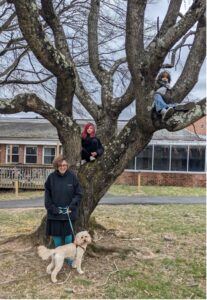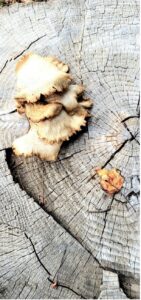Reflections by two Friends House residents, one in Assisted Living and one in Independent Living.
When we look out the windows from Haviland Hall-assisted living, we see some interesting trees. One of them is a large Japanese maple, its leaves now turning orange and red. Looming over it, still green in October, there is a very old sweet gum. We can also see one corner of the greenhouse. Between it and the garden, we admire a stately white pine. These trees are constant companions of residents in Haviland Hall; they encourage us to go outside and enjoy them more personally.

For our tree walk we leave the building by the door near Physical Therapy. Looking to the left, toward the Miller Center, we admire a huge old sour cherry tree. This tree dates from the founding of Friends House, so it must be at least sixty years old. Now, in the Fall, it has already lost most of its leaves. Its twisting branches are beautiful in their own way. In the Spring this cherry gives us a week of spectacular pale pink blossoms. Then it provides leafy green shade all summer. With its thick trunk branching into three parts close to the ground, it’s a wonderful tree for climbing.
There is a younger Japanese maple up against the wall of new C wing, where vacant apartments are being enlarged and renovated. It too is turning red after a mostly green summer. At the end of new C wing, there is an old dogwood; like dogwood trees all over our campus, this tree in the Fall shows burgundy leaves. We are so glad that the renovation project has been able to save these trees while improving some obsolete indoor spaces.
Moving on to the D wing courtyard, there are two huge old trees. One of them is an American beech tree and the other is a linden. There’s a picnic table between them. They give very deep shade, almost year-round. We wonder whether it’s hard for the grass to grow under them. They have such thick gnarled trunks. [picture 2, two D wing trees with picnic table.]
Heading on past the greenhouse, with its thriving purple asters, we turn to admire the tall white pine at the edge of the garden. Going on toward Quaker Lane, there are tables and chairs under a willow oak where workers from the renovations project are eating lunch. Closer to D Wing is a Kentucky coffee tree, all its leaves already on the ground.
Around the newly renovated Memorial Garden, we notice four young white fringe trees that were planted within the last few years. Then we stop at the Behre memorial bench (put there in1992) under a sweet gum and think about all the generations of residents who have rested in this spot, enjoying the shade of this old tree. From here we can see, over the roofs of the founders’ cottages, the wooded parkland that flourishes between Friends House and Sandy Spring Village. Probably, on this warm Fall day, there are Friends House residents walking the well-tended trails in these lovely woods.
From here we go around the low end of the garden, admiring the old and very productive peach tree near the composting enclosures. Reaching the newest part of Friends House Road, we talk with two cottage residents. They remind us that, of the five original Kwanzan cherry trees, four were removed when the road was extended to make the “cottage loop” a few years ago. One yard still has an original tree remaining. It is very beautiful and gives lots of shade. Another front yard has a new cherry tree, planted about two years ago to console us for the loss of the older cherries.

Moving south on Friends House Road, we visit the new duplex cottages. These were built on land that had been the site of a Christmas tree farm run by Friends House residents. Almost all the pine trees are gone now, replaced by houses and gardens, bioretention ponds, and a few new oak and dogwood trees.
As we return to the back entrance of Haviland Hall, we study the stump of a sugar maple that was removed long ago from the C Wing courtyard. Just now mushrooms are sprouting from the surface of the stump. A friend counted 46 annual growth rings, but the tree itself has been gone a long time. Even so, like our Friends House community, this relic is still sprouting new life.


